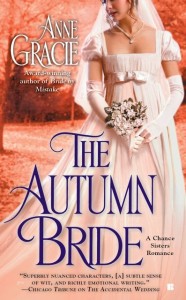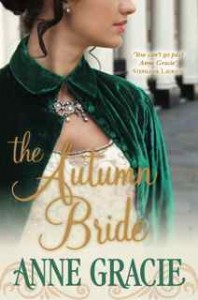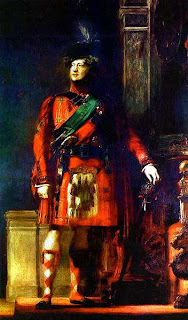 Diane here to welcome back fabulous Australian author Anne Gracie who is here to talk about her latest, The Autumn Bride. Anne is the award-winning author of Regency Historical Romance (and a few others).
Diane here to welcome back fabulous Australian author Anne Gracie who is here to talk about her latest, The Autumn Bride. Anne is the award-winning author of Regency Historical Romance (and a few others).
Anne and I have mutual friends in Australia. When her first book, A Gallant Waif, was a RITA finalist in 2000, and Anne came to the Romance Writers of America conference, we were supposed to meet and have a little chat, but we kept missing each other. It was only on the last day we managed a quick hello.
I’m delighted to have Anne as our guest today and to manage a “virtual” chat about The Autumn Bride, which has received some wonderful reviews.
Reviews
Publishers Weekly starred review: Gracie . . . charms and entices with this launch of the Regency-era Chance Sisters series. . . . Layers of secrets and deft characterization make for a deep, rich story that will leave readers starry-eyed.
Romantic Times, 4 1/2 stars: Readers will want to take a a chance on this delightful, heartwarming series about sisters of the heart, family, friends, and the fun and passion of romance. Gracie lifts readers’ spirits, creating a delightful cast of characters, tender moments and lighthearted repartee designed to tug at the heart. Keep a hankie handy for tears of laughter and joy.
Nightowl Reviews: I honestly can’t remember the last time I’ve enjoyed a book quite this much. . . . I predict The Autumn Bride is going to be “THE” book to add to the TBR list of Historical Romance fans everywhere.
Giveaway
Anne will be giving away a copy of The Autumn Bride to one lucky commenter chosen at random.
Interview
1. Welcome, Anne. Tell us about The Autumn Bride.
This is the first book in a series about four young women, all orphans, who come together and form a kind of a family, When their situation goes from bad to worse, Abby, my heroine, climbs through the window of a nearby mansion hoping to find something to steal. Instead she finds a bedridden aristocratic old lady at the mercy of her neglectful, rapacious servants. The four girls move in with Lady Beatrice, pretending to be her nieces and sacking the servants. All goes well until Lady Beatrice’s nephew Max returns after nine years in the Far East. He’s not impressed to find his aunt under the sway of these impostors.
It’s a rags-to-riches, feel-good, fun story with a dark undertow. But mostly it’s about the joy of friendship, second chances, sisterhood — and love.
2. I love the premise and the concept of a hodgepodge family of women coming together. How did you come up with the idea of creating such a family, rather than one with traditional biological ties?
Thanks, Diane, I did have fun with it. And I’m from a family of four siblings, though these days we live very far from each other.
But I often like to write about people who’ve “fallen through the cracks” of Regency society — well born, but cut adrift from society through scandal, poverty, being orphaned, or through some other personal catastrophe. I’ve had a hero who was sent to sea at the age of seven, a heroine who travelled with the army, the son of an English lord who grew up on the streets of Naples, a heroine who grew up on the streets of Cairo, dressed as a boy and lots more. My stories are about their journey back — back to family, and back to the kind of society that should have been their birthright.
I also think that people today can identify with the idea of “sisters of the heart” — or as we say today, girlfriends. I think many of us are closer to our girlfriends than we are to our blood relatives.

Australian Cover
3. What is risky about The Autumn Bride?
There are a few risky things — firstly the hero didn’t make his entrance for quite a few chapters. I was a bit worried that readers wouldn’t like that, but sometimes you have to write the book the way it needs to be written, and I loved the relationship that developed between the four girls and the feisty, bedridden Lady Beatrice. Luckily, a lot of readers feel the same.
Then there was my heroine’s risk when she climbs through the window of a mansion intending to steal, risking hanging or transportation. Here’s an excerpt:
The sash window was stiff, but she managed to push it up some more. She leaned in, listened, checked. Not a sound. A bedchamber. She could see the heavy hangings of the bed, an ornate wardrobe, a dressing table. No sign of life.
She swung one leg over the sill, heaved and she was in. She crouched a moment in the darkness, waiting for her eyes to adjust to the gloom, breathing deeply until her racing heart slowed.
Now to seek what she had come for. She crept toward the dressing table.
“Have you come to kill me?” The hoarse whisper coming out of the darkness almost stopped Abby’s heart. She swung around, scanning the room, braced to flee. Nothing moved, only shadows lit by the faint shimmer of moonlight from the windows where she’d pulled back the curtains. No sign of anyone.
“I said, have you come to kill me?” It came from the bed. Sounding more irritated than frightened.
“No, of course not!” Abby whispered back. She tiptoed closer to the bed, straining her eyes in the darkness. What she’d taken for a bundle of clothes piled on the bed was an old woman lying awkwardly, fallen between her pillows, her bedclothes rumpled in a twist.
“You’re a gel. Wearing breeches, but I can still tell you’re a gel.”
“Yes.” Abby waited. If the woman screamed or tried to raise the alarm she’d dive out of the window. It was risky, but better than being hanged or transported.
“You’re not here to kill me?”
“No.”
“Pity.”
Abby blinked. “Pity?”
4. Did you come across any interesting research when writing this book?
Not really — this story is more about characters than facts. Mostly the new research I did was about the district Lady Beatrice and the girls lived in, which centuries before had been a rich area filled with mansions, but in the Regency era was in decline, and starting to be redeveloped. Just like it happens today.
5. What is next for you?
I’m writing the second story in the series, and it’s more conventional in that the hero is on the page from the start. But the community of characters that’s in the first book is continuing, too. I really love the world of this story and I’m having a lot of fun with it.
Thanks Diane for letting me come and play with the Riskies.
Here’s a question for readers: “Is there anyone in your life that you consider ‘family’ even if they aren’t?”
I’ll give a copy of The Autumn Bride to one lucky commenter.
Diane here again. Anne will be back to answer any questions and to respond to comments, but, remember, she’ll be sleeping part of the time we’ll be awake, because she’s on the other side of the world!










